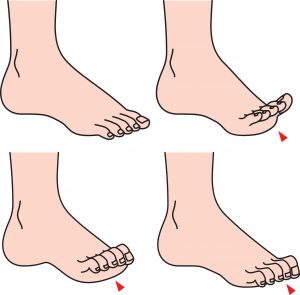Dr. Brian Nagy | March 6th, 2018
Posted In: Hammertoe
 If you’re living with the pain and mobility issues caused by a hammertoe, a minimally invasive surgery to correct your toe deformity may be the best treatment to resolve your symptoms. Minimally invasive surgeries have improved patient outcomes, reducing many of the risks of traditional surgery. Before we get into the details of what to expect during and after hammertoe surgery, let’s take a step back and review the basics about hammertoes.
If you’re living with the pain and mobility issues caused by a hammertoe, a minimally invasive surgery to correct your toe deformity may be the best treatment to resolve your symptoms. Minimally invasive surgeries have improved patient outcomes, reducing many of the risks of traditional surgery. Before we get into the details of what to expect during and after hammertoe surgery, let’s take a step back and review the basics about hammertoes.
A hammertoe is a deformity of your toe, where the middle joint is pulled out of alignment by tight muscles or tendons. This causes your toe to curve into the shape of a hammer or a claw. The deformity typically causes calluses or corns to develop on the toe. If left untreated, hammertoes can become painful and cause mobility issues. In some cases, you may end up not being able to walk without an assistive device like a cane.
Hammertoes develop when a muscle imbalance develops and from wearing shoes that cramp your toes, like high heels or shoes with pointed, narrow toe boxes.
Hammertoes are common in women who wear high heels and children who wear shoes that are too small. The reduced space in the toe box causes your toes to bend to fit in the available space. When your toes are stuck in this abnormal position for too long, your muscles tighten and get stuck in a contracted position.
When you continue to wear shoes that cramp your toes, your toes rub against the inside of your shoes, creating calluses and corns, which can exacerbate your hammertoe.
When hammertoes are diagnosed and treated early, you can usually avoid surgery. Initially, you should change your shoes, switching to shoes with a wide toe box. Custom orthotics can also help to support correct alignment in your foot. You might also be advised to have physical therapy to correct the muscle imbalance in your foot.
However, when these conservative treatments don’t correct your hammertoe or if the deformity has become too severe, you may need surgery to correct your toe. Traditionally, hammertoe surgery involved incisions along the tops of your toes, which allowed your podiatric surgeon to release your affected toe joints and the tight tendons and muscles. While effective at relieving the hammertoe, these surgeries required a long recovery time and often resulted in a lifetime of swollen and stiff toes.
Fortunately, advances in medical technology have led to a minimally invasive approach to hammertoe surgery. Minimally invasive surgery requires only a few small incisions. Your podiatric surgeon inserts specially designed surgical tools through the incision to release the tight tendons and muscles. Your surgeon may use an X-ray machine or a thin surgical tool with a camera mounted on the tip to create images of your toes to guide the surgical procedure.
If you have minimally invasive surgery to correct your hammertoe, the procedure is completed in an outpatient setting with a local anesthetic. You can have sedation, but it’s not necessary. Minimally invasive surgery improves patient outcomes by reducing the risk of infection and scarring. Also, as the joints are left intact, your recovery time is much shorter. Most patients are back on their feet and participating in normal activities within three weeks of minimally invasive hammertoe surgery.
After your procedure is complete, your trusted podiatrist closes the incisions with a stitch and applies compression dressing. You will be able to walk immediately after your surgery but should take it easy and keep your foot elevated for three or four days. You may need to wear splints on your treated toes for up to six weeks and you may benefit from physical therapy to improve flexibility in your foot and to keep the muscles strong and supple while you heal.
If you have a hammertoe or are concerned that a hammertoe is developing, contact us at Nagy Footcare for effective diagnosis and treatment. Our best day is when you wake up without foot pain.
« What are the Beginning Stages of an Ingrown Toenail? | 3 Types of Foot Strikes That May Cause You Foot Pain While Running »